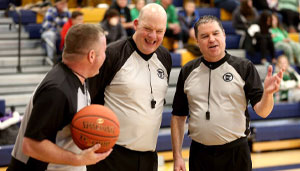An essential component of effective tennis is maintaining focus throughout the inevitable ebbs and flows of a match. Tennis is similar to boxing in that players are alone on the court with limited coaching allowed. Singles can be particularly stressful as there are no teammates to lean on or share success and failure with.
Developing a routine with strategies and techniques helps players maintain focus on court, play to the best of their abilities, and limit negative reactions. The key to a successful routine is to provide customized strategies and techniques and to prepare, execute, and reflect effectively.
PREPARE
The most important part of maintaining focus on court begins before the match even starts by creating a pre-match routine designed to boost player performance through mental strategies and techniques. The following are basic tenets of a pre-match routine that coaches can introduce to players.
Tailored Approach. Every player is unique and there is no one-size-fits-all routine. Some players benefit from a relaxing, stress-free preparation while others benefit from an energetic, psychologically-stimulating preparation. Players should be tasked with crafting their own tailored approach that ultimately will increase peak performance. This requires a great deal of trial and error and players should keep a log of techniques used with notes on their effectiveness or ineffectiveness.
Start Early. How early a player begins preparing for a match is up to the individual. Some may benefit from preparing in the days leading up to a match while others may become too keyed up by this approach and prefer beginning a routine a few hours before taking the court. Early preparation can be as simple as packing a tennis bag the night before and can be as complex as incorporating visualization techniques.
Optimal Energy Level. Players should consider whether they prefer a low-energy, calm, and relaxed environment before a match or a high-energy, stimulating environment. Either environment can be created through the use of music, pre-match workouts, or other various activities. Trial and error is important in determining which approach is best and coaches should encourage players to take notes on how each energy level affects their play.
Visualization. Thinking about a match beforehand can alleviate stress but can also have the reserve effect and heighten nerves. Players can use basic techniques such as thinking about the match during the day or advanced techniques such as visualizing themselves walking onto the court, putting their bag down, and warming up with their opponent. The effectiveness is entirely dependent on the individual player and may calm some while exciting others.
Pre-Match Activity. Players should find an activity that will help them maintain their optimal energy level before a match. Activities such as listening to music, reading, drawing, doing homework, taking a walk, or talking with friends will help players manage stress levels and ultimately promote focus during a match.
Logistics. In an effort to reduce stress as much as possible, players should pack their tennis bags and lay out their outfit as early as possible. This careful planning will encourage players to think about the match in a healthy way while reducing any stress that could be caused by forgetting any items the day of a match.
Preparing for a match is a great way for players to monitor and mold their energy and stress levels, setting themselves up for peak performance. Ultimately, there is only so much that preparation can do and players need to develop strategies and techniques that can be utilized during a match to maintain focus.
EXECUTE
Even with an optimal pre-match routine, there is no way to fully prepare for the unknown obstacles that can arise during a tennis match. It is imperative for players to develop in-match strategies and techniques to help them deal with anything and maintain focus throughout. Whether it is a great day or an off day, poor weather conditions, or an opponent making poor line calls, there are numerous ways in which a play can lose focus. The following are strategies and techniques that coaches can introduce to players to help them navigate the peaks and valleys of a tennis match.
Control. In tennis – and sports in general – there are precious few things that players can control. Players cannot control their opponent’s pace or style of play. They cannot control the conditions of the court or the weather. Players should find the little things that they can control, such as making sure that all three tennis balls are in their preferred location before serving (e.g. one in hand, one in pocket, and one against the fence). Feeling in control will alleviate stress and help players cope with any discomfort associated with the overall lack of control.
Ritual. Developing a ritual, such as dribbling a ball with their racket before serving, will help players create a rhythm that makes them feel most comfortable. Each player will have a unique ritual and some may even opt for no routine at all.
Self-Talk. High school tennis allows for some coaching but players are out on the court by themselves for the vast majority of the match. Players should talk to themselves and serve as their own coach and own motivator. Coaches should beware that some players have a tendency to talk to themselves in a negative manner. This should be monitored and discussed with the team to encourage positive, motivating self-talk.
Embrace the Elements. A whipping wind, a particularly cold day, or a hot and humid day can easily throw a tennis player off and affect their game negatively. Furthermore, it can affect them mentally as they begin to question their own ability to navigate poor weather conditions. Players should embrace the elements and adapt their playing style to the current weather conditions instead of trying to play through the conditions.
Rhythm. Tennis matches can be long and often have swings of momentum and ups and downs. Players are often drawn into keeping a particular rhythm of a match whether it is helping or hurting them. Players should develop the habit of noting the rhythm of the match at any given point and deciding how comfortable they are with that rhythm. Taking note of the pace of the match and adjusting that pace to ensure it is within a comfortable range will ultimately prevent players from slipping out of focus.
Pre-match routines, in-game strategies, and techniques are vital to maintaining focus. Performing simple exercises after a match geared towards reinforcing positive focusing skills will ultimately contribute to peak performance in future matches.
REFLECT
Evaluate. An integral component of this entire process is re-examining pre-match routines and in-game strategies and determining what was effective and what needs to be tweaked or removed completely. Players should keep logs and notes that will lead towards an effective tailored plan.
Calm Down or Rehash. Some players are best off mentally putting a match aside and focusing on something else while others benefit from rehashing a match and playing it again in their mind. Strategies such as going for a walk, going for a run or talking with friends and family will help some players calm down while rehashing a match will help others decompress and make sense of the match.
Mindfulness. High school athletics offer a great opportunity for players to represent their school, enjoy being part of a team, and learn valuable life lessons. Players should be encouraged to enjoy all of the experiences that come along with being part of a team and representing one’s high school.
Kirby Morrison
Kirby Morrison has been coaching high school tennis for four years and is currently the varsity tennis coach at Ursuline Academy (Massachusetts). Morrison is a Guidance Counselor at a PreK-8 school in Boston, where he coaches the 7th and 8th grade basketball team.
Most Recent Articles
- nfhs news NFHS Learning Center Delivers 25 Millionth Course
- Track & Field/Cross Country article Effective Communication with Athletes and Coaches
- nfhs news Player Equipment Changes Highlight 2025 High School Football Rules Revisions
- Player Equipment Changes Highlight 2025 High School Football Rules Revisions
- nfhs news Judgment Call on Second Contact Eliminated in High School Volleyball






